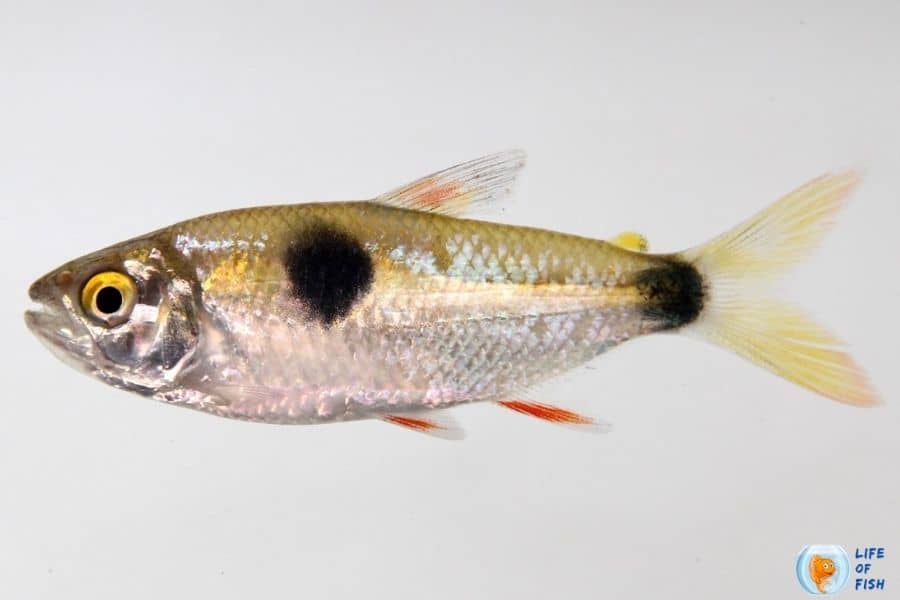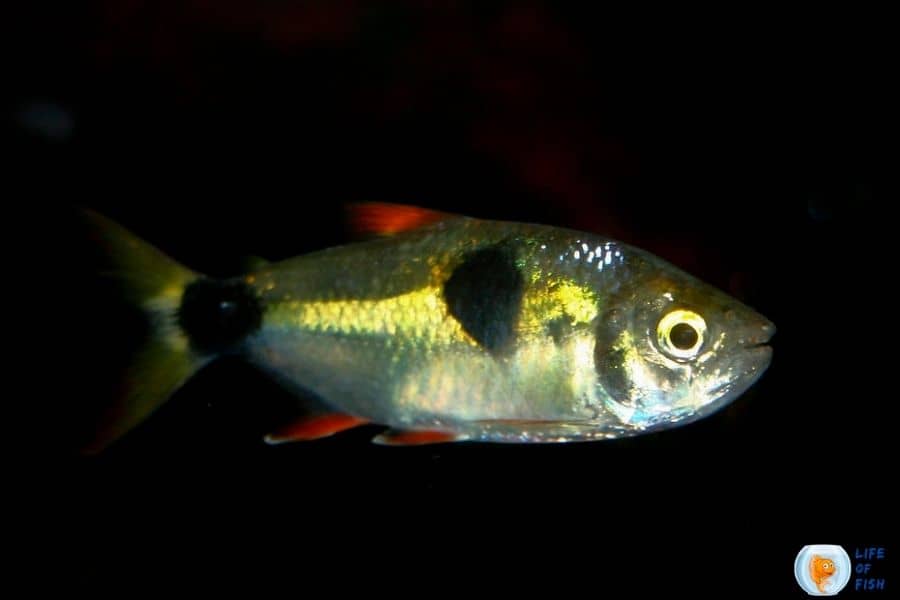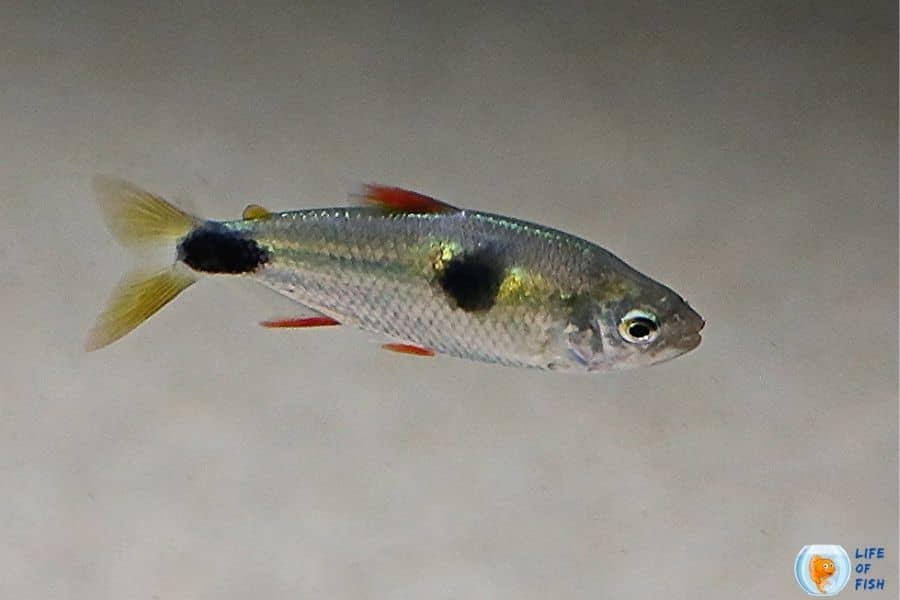Bucktooth Tetra is freshwater fish, that is apparently the same as other tetra fish. However, not like their peaceful cousins, these are predatory and wildly aggressive.
They don’t have protruding teeth as their name suggests! These small fish are torpedo-shaped, tiny, and brightly colored.
The primary color of their body is metallic silver and has hues of yellow, green, and red. There are two huge black patches on their body.

One is located in the middle portion of the body, while the other is found at the base of the tail. Their fins are nearly transparent but have a hue of yellow.
To be more colorful, their dorsal, pectoral, and anal fins have red and orange splotches. In addition, their tail is bright yellow.
Despite, how beautiful they are, they are very aggressive fish; but still famous and among many aquarists.
Although they don’t have protruding teeth, they have fang-like sharp teeth and they are pointy and fairly keen to aid the fish’s scale-eating behavior.
The Bucktooth tetra is native to Amazon River Basin. They are widely found in Brazil and Guyana and they are one of several scale-eating species of their native land.
They belong to the characin family of order Characiformes. It is the only member of the genus Exodon so far. The Bucktooth Tetra is scientifically known as Exodon paradoxus.
How big do Bucktooth Tetra get?
Jump To
They are small fish and grow to a length around four to five inches when kept in captivity. However, they can reach up to six inches in length in the wild.
Although many aquarists tried to grow them over 5 inches, by providing proper conditions and meals they failed to do it for some reason which is still not discovered!
Is Bucktooth Tetra aggressive?
Yes, they’re highly aggressive fish toward other fish species. When there are not in a large group, they are aggressive toward the same species too.
Bucktooth Tetra behavior
As mentioned earlier, they are very aggressive species towards other fish species. However, they need to stay in groups to thrive as individuals.
They show cannibalistic behavior when there is a small number of individuals which means they try to fight and eat each other !!.
Determining the number of individuals for a group is a matter of the tank size. Generally, there should be at least 12 individuals in a group.
When they are in a shoal, no single Bucktooth will be targeted and killed. Instead, they looking for sick or unhealthy fish to attack.
They pray small fish and also they can threaten large species too. They attack large fish in a group and eat their scales which may end up in the death of the targeted fish.
When they eat the scales of large fish, a group will swarm their prey and attack from all directions! This is the same as the behavior of piranha.
They are very active fish and create a beautiful display thanks to their rich color combination when they swim as a group. Usually, they, swim and attack as a group. But occasionally they separate to do their own thing and then again join the group.
They are not shy as other tetra species and behave very confidently in the aquarium.
How long do Bucktooth Tetra live?
The life span of Bucktooth tetra is about 10 years and this is quite the same as the other tetra species.
However, like many other aquarium fish, their lifespan in captivity depends on the water parameters, quality of food, and well-maintained environment.
Therefore, it is important to give them proper care to keep their life expectancy to 10 years.

One look Care guide
| Scientific name | Exodon paradoxus |
| Common name | Bucktooth tetra |
| Care level | Hard |
| Native to | Amazon river basin |
| Type | Freshwater fish |
| Color | Metallic silver with hints of red, green, yellow |
| Tank size | 55 gallons for a group of 12 |
| Preferred temperature | 72°F to 82°F |
| Other water parameters | pH: 5.5-7.5 Hardness: dGH |
| Preferred salinity | Freshwater fish |
| Size | 4-5 inches |
| Growth rate | slow |
| Temperament | Aggressive |
| Recommended tank mates | Better only themselves only, otherwise, Loricarrids, loaches and large characins are suitable |
| Preferred food | Chopped prawns Clams Bloodworms Plankton Lance Fish Earthworms |
| Feeding frequency | Several times per day |
| breeding | Egg layers, hard in captivity |
Bucktooth Tetra care
Bucktooth Tetra size
The size of Bucktooth tetra is about 4-5 inches in captivity and they can reach 6 inches in length when they are in their natural habitats.
Bucktooth Tetra tank size
Despite their small size, they need quite a large tank. These are very active fish and need ample space to swim around.
In addition, they are shoaling fish, and to avoid cannibalistic behavior you need to keep many Bucktooth tetras together.
Therefore, it is recommended to have at least 55 gallons tank for a group of 12 individuals and even a large tank is better.
If you have Bucktooth tetras than 12 you must adjust the tank size according to the number of individuals.\
How many Bucktooth Tetra should be kept together?
It is good to keep as many as your aquarium size allows you to. You cannot keep Bucktooth tetras below 10-12 individuals as they begin to fight with each other.
At least 12 tetras should be kept in the aquarium to avoid cannibalism. There is no maximum amount and you can keep even 50 -60 tetras if you have a large aquarium
Anyway, if you have only two or three tetras, it is better to keep them alone in different tanks.
Tank setup
Like many freshwater species, they are not seeking the protection of plants to hide. However, you can put some live plants in your aquarium as there is no clue that the Bucktooth tetras harm them.
Java fern, and Amazon swords are the top-ranked plants. Even, you can put any floating plants or grass-like plants.
Make sure, that you are not overcrowding the tank with plants. Keep the plants and other decorations such as driftwood, and rocks on the perimeter of the tank allowing more space for fish to roam.
These fish like to stick to the middle and top of the water column and make sure, there is plenty of space to swim freely.
As their l substrate in their natural environment is sand, it is better to use sand for the substrate.
Though do not like to stick in the bottom of the tank they occasionally come down for looking for food. Many aquarists suggest that using dark sand material is good.
Though they are not interested in caves or flat rocks there is no harm to put them in. However, make sure not to overcrowd the space with decorations.
Water quality condition
Bucktooth tetras are hardy fish and aren’t too demanding when it comes to water parameters. They can live in average water conditions suit to many South American tropical fish.
They are originated from the Amazone water basin, where there is warm water. Therefore, they need warm water ranging from 72°F to 82°F.
The ideal temperature is 75°F. Consider installing a water heater to keep the water in this range.
They live in slightly acidic water, in their natural environment because of heavy plant debris in those areas.
The recommended pH level is 5.5 to 7.5. It is better to aim at slightly acidic water as it resembles their natural environment. The recommended water hardness is 0 to 15 KH.
Although they are not demanding for water quality it is always good to check the water quality regularly to make sure any of the parameters does not slip to a dangerous level.
Bucktooth Tetra breeding
Bucktooth Tetra male or female identification
Though it is not easy to distinguish between male and female Bucktooth tetras, they can be identified by closely examining their body shape and fins.
Mature males tend to be slimmer than females and they tend to have slightly elongated dorsal and anal fin rays than females.
Bucktooth Tetra breeding
Though It is not hard to breed them in captivity, there are only a few successful cases reported for breeding in captivity.
Select a pair of fish in good condition and transfer them to the spawning tank. The tank of 24″ x 12″ x 12″ is enough for the spawning process.
You Can put some fine-leaved plants into the spawning tank in order to catch the eggs. Also, these plants add some protection to the eggs from the adults The tank base should be covered with a mesh.
This should be big enough to fish eggs can fall through it and small enough to prevent the adult fish from reaching them.
The mesh acts as an egg pouch and it saves the eggs from the adults. The water should be slightly acidic in the range of 6.0-6.5.
The spawning can be triggered by performing a large (50%+) water change. At the same time increase the water temperature by a few degrees to resemble their breeding season in their natural environment.
Always keep an eye on them to remove the adults once they lay eggs. Bucktooth tetra is known to eat their own eggs.
It will take an average of 2 to 3 days to hatch the eggs. There is little information about raising the fry. However, cannibalism is common among the fry and juvenile too .
Therefore keep a few tanks to keep the fish of different sizes as they grew up. Always make sure to feed them properly, and it will reduce their stress on foods and help to minimize their cannibalistic behavior.
How many babies does Bucktooth Tetra have?
It depends on several factors. However, you may lose a certain amount of fry, as they are eating themselves even at their fry stage.
Bucktooth Tetra fry care
After you see the free-swimming fry, you can feed them with baby brine shrimp. Always keep an eye on them to avoid them being eaten by themselves. It is better to keep a few tanks to separate the different sizes as they grow up.

Feeding behavior of Bucktooth Tetra
What do they eat
As described earlier, Bucktooth tetra is carnivorous fish species. In the wild, their main meal is fish scales and insects.
Although some aquarists find that, it is a bit difficult to get used to their unique feeding experience they easily adapt to other meals too. Apart from the scale and insects they eat worms in their natural environment.
In captivity, you can feed them meaty meals such as bloodworm, chopped prawns, mussel, brine shrimp earthworms and lancefish.
They accept most dry and frozen foods too. However, make sure you feed them with the proper amount because they become aggressive when they are not fed well.
Some aquarists feed them with dead fish and feeder fish to fulfill their need to eat scales.
They are greedy species and some locals in their native land put their dirty pans and dishes to the water and they will clean the pan and dishes by scraping every bit of food.
How often should you feed
Bucktooth Tetra should typically be fed every few hours, several times a day.
When should you feed (time of the day)
They are diurnal animals and better to feed them during the daytime
How long they can go without food
They are vigorous eaters and therefore could not survive long without food. On the other hand, the stress of not having food makes them more aggressive and they tend to eat themselves.
What fish can live with Bucktooth Tetra?
Due to their aggressive nature, no species can live with them. You can keep them with 20 to 25 Bucktooth Tetra fish.
Reducing the number of members in the school will lead them to eat themselves until only one remain.
Some aquarists suggest that the Loricarrids, loaches and large characins like Anostomus are suitable tank mates for the Bucktooth tetras.
However, it is hard to predict how they behave and still good to add a group of Bucktooth tetras to the tank.
If you are adding other fish described above to a community tank with Bucktooth tetras keep in mind to add the Bucktooth tetras at last because they consider all the new adding as their food.
Related questions
Is Bucktooth Tetra aggressive?
Yes, the are aggressive toward their own species and other species.
Can Bucktooth Tetra live in a pond?
Technically, yes because they are hardy fish and can adapt to any environment
Read Next : Jaguar Cichlid | How To Care This Aggressive Fish |

